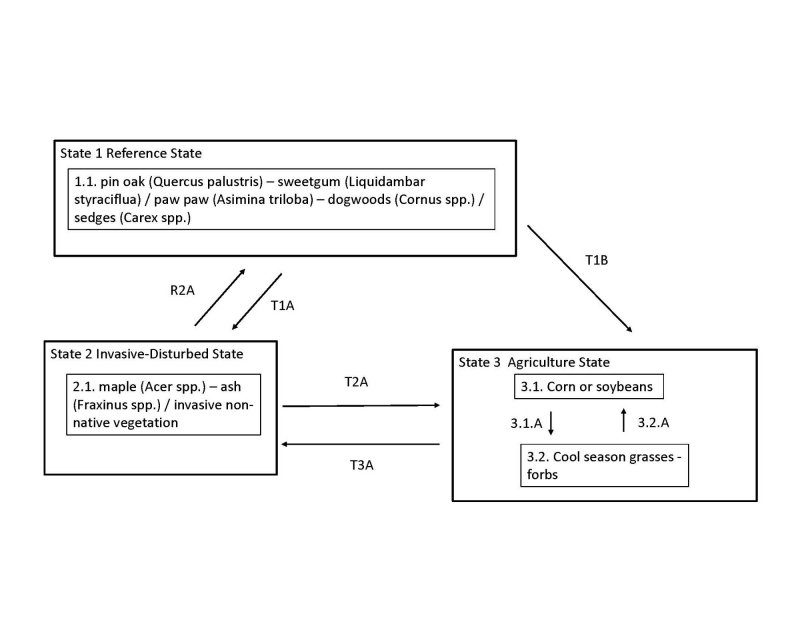
Natural Resources
Conservation Service
Ecological site F114XA501IN
Wet Till Flatwoods
Last updated: 9/26/2024
Accessed: 04/30/2025
General information
Provisional. A provisional ecological site description has undergone quality control and quality assurance review. It contains a working state and transition model and enough information to identify the ecological site.
MLRA notes
Major Land Resource Area (MLRA): 114X–Southern Illinois and Indiana Thin Loess and Till Plain
MLRA 114A makes up about 4,550 square miles (11,795 square kilometers). The three parts of this MRLA are mostly in the Till Plains Section of the Central Lowland Province of the Interior Plains. The western third of the western part is in the Highland Rim Section of the Interior Low Plateaus Province of the Interior Plains. The eastern half of the eastern part is in the Kanawha Section of the Appalachian Plateaus Province of the Appalachian Highlands. Both large and small tributaries of the Ohio River dissect the nearly level to very steep glaciated uplands in this area. The major streams and rivers have well defined valleys with broad flood plains and numerous stream terraces. The flood plains along the smaller streams are narrow. Broad summits are nearly level to gently sloping. Elevation ranges from 320 feet (100 meters) on the southernmost flood plain along the Ohio River to 1,250 feet (380 meters) on the highest ridges. Local relief is mainly 10 to 50 feet (3 to 15 meters), but it can be 50 to 100 feet (15 to 30 meters) along drainageways and streams. Also, the Ohio River bluffs are as much as 300 feet (90 meters) above the river valley floor.
Classification relationships
USFS: 222 Eastern Broadleaf Forest (Continental) Province
Homoya's Natural Regions of Indiana: Bluegrass Region
The following NatureServe Explorer Ecological System has a high level of probability to match the ecological site found on these soils: North-Central Interior Wet Flatwoods, Unique Identifier: CES202.700
Ecological site concept
The Wet Till Flatwoods state is a mature forest with wet-tolerant species including swamp white oak, pin oak, sweetgum, beech, green ash, and maple. Swamp chestnut oak and blackgum may also be present. Stands occur on somewhat poorly drained to poorly drained uplands or in depressions on level glacial lakeplains or outwash plains. There is an impermeable or nearly impermeable clay resulting in a shallow, perched water table. Ponding is common during the wet seasons and droughts in the summer, leading to a complex of forest upland and wetland species. Deciduous hardwoods and softwoods predominate. Shrubs may include black chokeberry (Aronia melanocarpa), paw paw (Asiminia triloba), and strawberry bush (Euonymus obovatus).
The herbaceous layer, can be sparse to dense, depending on the ponding regime. Length of flooding and depth of clay layer will influence the understory native plant community. Understory species may include Boehmeria cylindrica, multiple Carex species (Carex blanda, Carex laxiculmis, Carex squarrosa, Carex intumescens, etc.), Elymus riparius, Elymus virginicus, Cardamine bulbosa, Cardamine pensylvanica, Claytonia virginica, Oxalis violacea, Podophyllum peltatum, Galium tinctorium, Glyceria striata, Mitchella repens, Osmunda regalis, Osmunda cinnamomea, and Cinna arundinacea.
The majority of these sites are now agricultural and being utilized as cropland or pastureland. Natural hydrology has been modified via tiling and ditching Few mature, high-quality, reference communities still exist today.
Associated sites
| F114XA502IN |
Till Uplands The Till Uplands groups is associated geographically but consists of better drained soil series and more upland plant communities. |
|---|
Similar sites
| F114XA101IN |
Wet Lacustrine Forest Wet Lacustrine Forest. This sites also have wet-tolerant forest species. |
|---|
Table 1. Dominant plant species
| Tree |
(1) Quercus palustris |
|---|---|
| Shrub |
(1) Asimina triloba |
| Herbaceous |
(1) Carex |
Click on box and path labels to scroll to the respective text.
| T1A | - | Disturbance; invasion of non-native plants |
|---|---|---|
| T1B | - | Site clearing; hydrology modifications; site preparation; tillage; seeding; agricultural production. |
| R2A | - | Long-term control of brush and weeds; timber stand improvement inputs |
| T2B | - | Clearing; site preparation; brush/weed control; agricultural management. |
| T3A | - | Abandonment; no management inputs |
State 1 submodel, plant communities
State 2 submodel, plant communities
State 3 submodel, plant communities
| 3.1.A | - | Seeding; weed control; grassland management |
|---|---|---|
| 3.2.A | - | Site preparation; tillage; weed control; row crop management |

